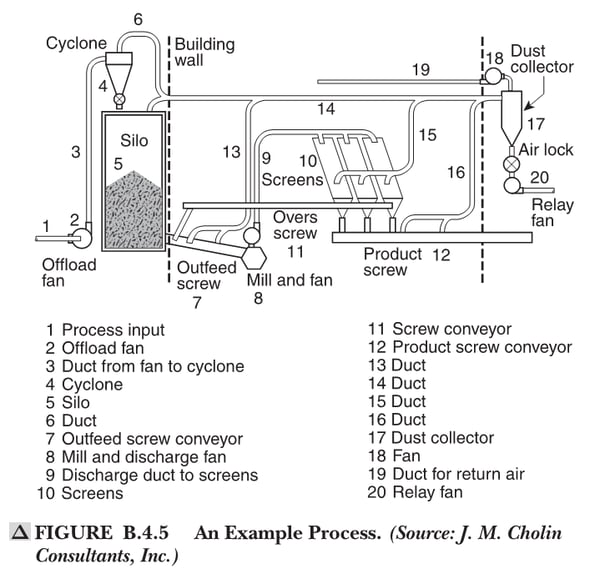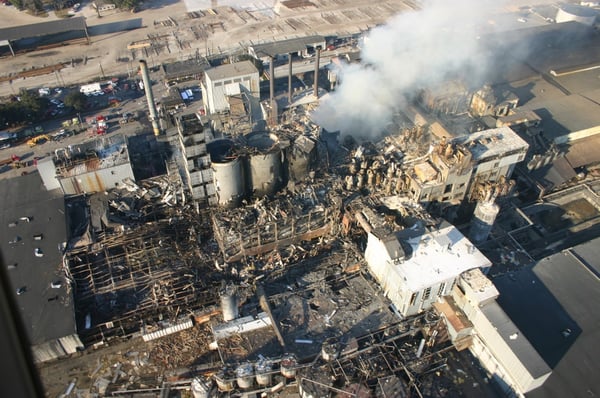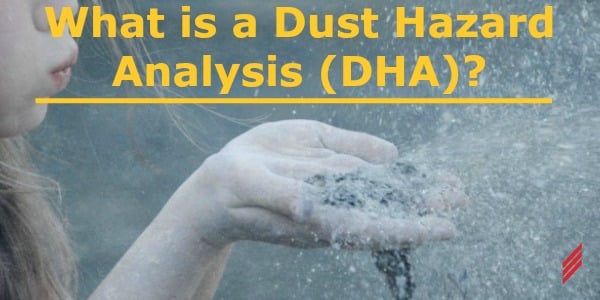- Get link
- X
- Other Apps
By
Jeffrey C. Nichols
-
A great article by
Chris Giusto at Hallam-ICS
In my last blog I discussed Combustible Dust Fundamentals and NFPA 652 and explained some of the background as to why NFPA 652 requires a Dust Hazard Analysis.
Blogs posts within this series:

The goal of your DHA is to identify all the hazards in your facility–especially the ones you did not even know existed. For example, the well-known Port Wentworth, Georgia Imperial Sugar Refinery explosion in 2008 was the result of unknown hazards. A conveyor enclosure created the necessary confinement for dust that was leaking and dispersed from silo outlets, and an overheated bearing inside the enclosure is believed to have been the ignition source. This initial explosion ignited several secondary explosions that had plenty of fuel due to fugitive dust accumulation and poor housekeeping. A DHA likely would have identified these hazards so they could have been addressed. (For a detailed discussion of this incident, you can listen to Episode 3 of the Dust Safety Science Podcast with Dr. Chris Cloney.)
While NFPA 652 does not explicitly define who is a ‘qualified person’, it does provide good guidelines for facility owners to consider when choosing a consultant/facilitator or assembling a DHA team. It is possible that you have internal staff who are qualified and capable of conducting a DHA for your facility, but do not discount the value of an outside perspective. A fresh set of eyes may identify hazards your staff could overlook, and someone who has performed DHAs in other industries can also provide valuable insights that apply to your facility and processes.
This is a situation where it truly is “better late than never.” Starting the process of conducting DHAs not only keeps you compliant, but also shows your employees that you are dedicated to their safety and serious about minimizing hazards in their workplace.
If you have questions or would like more information about DHAs and Combustible Dust Safety, you can contact Chris directly via email at cgiusto@Hallam-ICS.com.
About the Author
Chris Giusto is Director of Industrial Projects and works primarily with industrial facilities to improve processes & safety, reduce waste & energy consumption, increase flexibility & capacity, and build new facilities. He has nearly 20 years of mechanical engineering experience including design and specification of equipment and systems, detailed machine design, and project management. Areas of expertise include custom equipment design and fabrication, material handling, dust collection, and combustible dust safety.
Read My Hallam Story
Blogs posts within this series:
- Combustible Dust Fundamentals and NFPA 652
- What is a Dust Hazard Analysis (DHA)?
- A Practical Guide to 5 Important Properties of Combustible Dust
- 7 Steps to Complete a Dust Hazard Analysis
- I've Completed My DHA, Now What?
What is a DHA?
A Dust Hazard Analysis (DHA) is a systematic review of the processes and areas of your facility where combustible particulate solids are present. (Figure B.4.5 below from NFPA 652 shows how an example process is broken down into individual points to be evaluated.) The analysis will help identify the fire, flash-fire, and explosion hazards that exist in your facility. The DHA will categorize locations into one of three general categories: Not a hazard, Might be a hazard, or Deflagration (or Fire, or Flash-Fire) hazard. Locations that fall into the second category will often require additional information or analysis to determine if a hazard exists or not. For each hazard identified, safe operating ranges must be defined as well as any existing hazard management measures and a list of additional hazard management options for consideration.
The goal of your DHA is to identify all the hazards in your facility–especially the ones you did not even know existed. For example, the well-known Port Wentworth, Georgia Imperial Sugar Refinery explosion in 2008 was the result of unknown hazards. A conveyor enclosure created the necessary confinement for dust that was leaking and dispersed from silo outlets, and an overheated bearing inside the enclosure is believed to have been the ignition source. This initial explosion ignited several secondary explosions that had plenty of fuel due to fugitive dust accumulation and poor housekeeping. A DHA likely would have identified these hazards so they could have been addressed. (For a detailed discussion of this incident, you can listen to Episode 3 of the Dust Safety Science Podcast with Dr. Chris Cloney.)

Aftermath of the Imperial Sugar Refinery explosion (image form CSB.gov)
When is a DHA Required?
The short answer is always. The requirement to conduct a DHA applies retroactively to existing facilities and processes, and NFPA 652 also requires a DHA for all new processes and facilities.Who Performs a DHA?
This question does not have as simple an answer the one above. NFPA 652, Section 7.2.2 states:The DHA shall be performed or led by a qualified person.The Explanatory Material in Annex A (not enforceable, but provided for clarification) elaborates:
The qualified person who is leading or performing the DHA should be familiar with conducting a DHA. The qualified person should also be familiar with the hazards of combustible dusts. Typically, a team performs a DHA. For some processes this team might be as little as two persons, or for larger and more complex processes, the team might require many more than two persons. This team is made of a variety of persons whose background and expertise can include the following:The individuals involved in the DHA could include facility operators, engineers, owners, equipment manufacturers, or consultants.
(1) Familiarity with the process
(2) Operations and maintenance
(3) Process equipment
(4) Safety systems
(5) History of operation
(6) The properties of the material
(7) Emergency procedures
While NFPA 652 does not explicitly define who is a ‘qualified person’, it does provide good guidelines for facility owners to consider when choosing a consultant/facilitator or assembling a DHA team. It is possible that you have internal staff who are qualified and capable of conducting a DHA for your facility, but do not discount the value of an outside perspective. A fresh set of eyes may identify hazards your staff could overlook, and someone who has performed DHAs in other industries can also provide valuable insights that apply to your facility and processes.
Compliance Deadline for DHAs
NFPA 652 requires owners to conduct a DHA for existing facilities and processes by September 7, 2020. NFPA 652 was originally issued in 2015 with a 2018 compliance deadline, but the 2019 edition (effective May 24, 2018) extended the deadline to September 7, 2020. However, 652 also requires that owners demonstrate reasonable progress in completing DHAs each year prior to the deadline. If your facility has not yet started this process, you are already non-compliant.This is a situation where it truly is “better late than never.” Starting the process of conducting DHAs not only keeps you compliant, but also shows your employees that you are dedicated to their safety and serious about minimizing hazards in their workplace.
Summary
A DHA is a systematic review of the processes and areas of your facility where combustible dusts are present. NFPA 652 requires that you have a DHA complete for existing processes and facilities by September 7, 2020. And finally, if you haven’t gotten started, now is the time - this process can save lives.If you have questions or would like more information about DHAs and Combustible Dust Safety, you can contact Chris directly via email at cgiusto@Hallam-ICS.com.
About the Author
Chris Giusto is Director of Industrial Projects and works primarily with industrial facilities to improve processes & safety, reduce waste & energy consumption, increase flexibility & capacity, and build new facilities. He has nearly 20 years of mechanical engineering experience including design and specification of equipment and systems, detailed machine design, and project management. Areas of expertise include custom equipment design and fabrication, material handling, dust collection, and combustible dust safety.
Read My Hallam Story
About Hallam-ICS
Hallam-ICS is an engineering and
automation company that designs MEP systems for facilities and plants,
engineers control and automation solutions, and ensures safety and
regulatory compliance through arc flash studies, commissioning, and
validation. Our offices are located in Massachusetts, Connecticut, New York, Vermont and North Carolina and our projects take us world-wide.
Topics:
MEP Engineering,
Combustible Dust

By
Chris Giusto
- Get link
- X
- Other Apps

Comments
Post a Comment